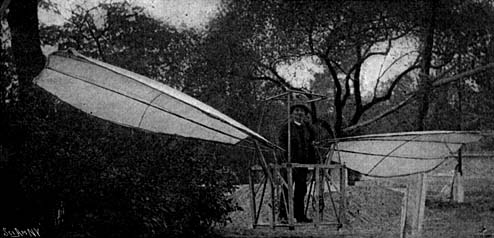

In the little town of Neuilly, France, lives a certain Emilien Marceau, who is a printer by trade. It happens that the printing business is not particularly brisk in Neuilly, for which reason Marceau must turn to other things in order fully to occupy his mind. From his shop windows he had ample opportunity to watch the birds and butterflies as they flitted by. After he had watched the birds and butterflies for several years, he was seized with the desire to fly. And thus it came about that Marceau joined the ranks of airship inventors. Butterflies fly because they have wings; therefore, a flying machine must have wings, he thought. He built himself a rude car, fitted with outriggers on which wings were pivoted, and coupled up these wings with a man-driven mechanism, consisting merely of a sprocket and chain which gave a reciprocating movement to the wings. With a kind of poetic fitness, or rather unfitness, Marceau christened his machine the "Butterfly." Here is Marceau's lucid account of the "Butterfly's" soaring possibilities:
"My car weighs 61 1/2 pounds; I weigh 165 pounds; total weight, 226 1/2 pounds. I fasten a balloon to my car, capable of lifting 220 pounds. I drive my machine by muscular force alone; and this muscular driving power gives me an additional lifting capacity of 44 pounds. That means I have about 38 pounds to spare. I must rise; my figures are conclusive."

MARCEAU'S "BUTTERFLY"
Unfortunately, Marceau has not the wherewithal to purchase a balloon, so that the conclusiveness of his cogent reasoning, however satisfying it may be to himself, is still open to question. Some day he may get his balloon; if he does, he will learn more about gravitation than was ever dreamed of in his philosophy.
Originally appeared in Scientific American, 89, December 12, 1903, p. 446.
cbgb